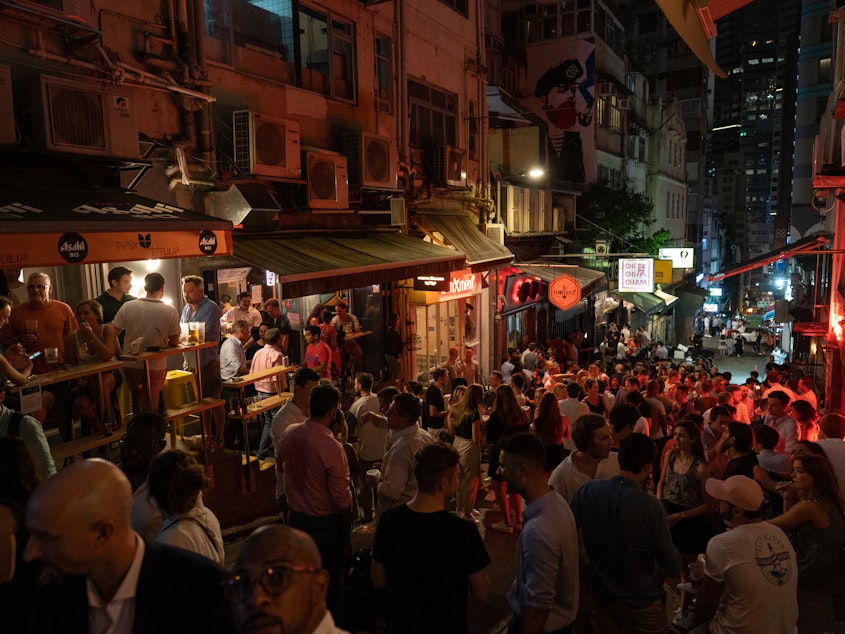Why The Novel Coronavirus Is So 'Superspready'

A person with a high viral load walks into a bar.
That, according to researchers who study the novel coronavirus, is a recipe for a superspreading event — where one person or gathering leads to an unusually high number of new infections. And that kind of occurrence is increasingly considered a hallmark of the coronavirus that causes COVID-19.
"There are some really good estimates out there that suggest that between 10% and 20% of cases are responsible for about 80% of transmission events," said Maria Van Kerkhove, technical lead for the World Health Organization's Health Emergencies Program, at a press conference August 10.
One such event has been traced to Hong Kong's Lan Kwai Fong nightlife district this spring, where an infected person (or persons) may have triggered one of the biggest coronavirus clusters in the city.
According to a preprint paper from The University of Hong Kong, the virus spread among 106 bar patrons, bar workers and musicians in that district over a period of two weeks in March.
The Hong Kong bar district had all the high-risk factors that make it easy for the coronavirus to spread, says Dr. Gabriel Leung, dean of medicine at The University of Hong Kong and a co-author of the paper. "Any setting that is an enclosed space that is poorly ventilated, that is crowded and that has unprotected behavior would tend to create a lot of clusters," he says.
Other respiratory diseases spread in clusters to some degree, says Jamie Lloyd-Smith, who researches disease transmission at UCLA and has looked into a wide range of past outbreaks. But for the COVID-19 coronavirus and the closely related SARS virus, which swept through Asia in 2003, these kinds of clustered transmission events seem to be a major driving force. "Both SARS and [the COVID-19 coronavirus] are at the relatively superspready extreme," he says.
And two of the main reasons, say researchers: the way this coronavirus spreads and the behavior of infected individuals.
A key feature that helps this virus superspread is its ability to transmit through the air in closed indoor settings, says Dr. Joshua Schiffer, an infectious disease physician and researcher at Fred Hutchinson Cancer Research Center and co-author of a recent preprint paper on superspreading events. Since in a superspreader event, one person can infect many others in the same room, that likely means the spreader is breathing out infectious virus particles that can hang in clouds in the air that hang in the air and can disperse over a wide area, he says.
Then there's the issue of when a person is contagious. During the 2003 SARS epidemic, people were most contagious about 10 days after developing a fever or cough. So keeping sick people away from the healthy stopped the virus from transmitting.
There still were a number of superspreading events during that outbreak — primarily traced back to hospitals and housing communities where infected people lived or visited.
But this novel coronavirus, known as SARS-COV-2, is more of a party-crasher. It appears to spread efficiently from people who don't yet know they're sick. Leung says research shows that 40% of coronavirus transmission is taking place before a patient shows symptoms. And people may actually be most contagious the day or two before they start feeling sick.
"Viral load actually increases a couple of days before symptoms show up," says Smita Gopinath, an immunologist at the Harvard School of Public Health. That's why so many superspreading events during this pandemic are taking place in bars, nightclubs, restaurants and factories. The virus is spreading from one person's respiratory tract to another's — even though the person who's spreading it may feel totally fine.
But just because you're infected doesn't mean you would definitely trigger a superspreading event. Some people may naturally spread the virus more effectively than others, says Seema Lakdawala, a flu researcher at the University of Pittsburgh. It may come down to differences in biology, such as how much virus a person sheds in sighs and coughs and sneezes — or even how the virus comes out from the respiratory tract.
"It could be that people who have really sticky mucus are more likely to be superspreaders," she posits, based on flu studies that have shown that viruses can live longer in some people's mucus versus others.
To learn more about this phenomenon of superspreading, scientists are working to untangle which details of person, place and time matter most. But even at this relatively early stage in the pandemic, it is clear that the novel coronavirus is suited for superspreading, from its ability to survive in the air to its spreadability even when a person is not yet symptomatic. That's "bad news," says Gabriel Leung, and means that containing the coronavirus requires more intensive interventions than past disease outbreaks like SARS.
So when a person with a high viral load walks into a crowded bar — one with poor ventilation, where nobody is wearing masks or social distancing — that's a superspreading cocktail. [Copyright 2020 NPR]



